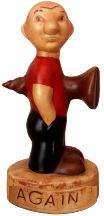 |
 The Virtual Corkscrew Museum's Weekly Newspaper |
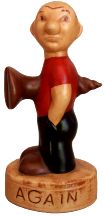 |
 |
 The Virtual Corkscrew Museum's Weekly Newspaper |
 |
|
Sunday, April 5, 2009 |
Number 551 |
The Buddy Knife
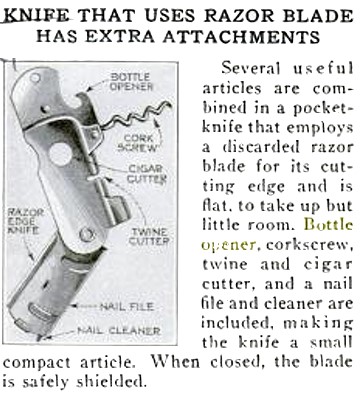
From Popular Mechanics March 1927
On April 15, 1926, Carl Horix of Chicago, Illinois filed an application for patent for his "Combination Tool". U. S. Patent No. 1,717,925 was issued on June 18, 1929. Horix noted his implements were "effectively encased when not in use so that the tool may be carried in a pocket without danger of tearing the lining of the pocket." A standard razor blade is sandwiched between the two side plates (handle) and is pivoted to cut cigars tips in the center hole. When the blade is fully opened there is small projection on the plate which is intended as a fingernail cleaner. At the opposite end is a bottle cap remover. The plates are formed to accommodate a pivoting corkscrew. The tool was produced by the Greist Manufacturing Company of New Haven, Connecticut under the trade name "Buddy-Nife". Greist was a manufacturer of straight razors. The tool was also available for advertising purposes. Pittsburgh's McKenna Brass & Mfg. used it to promote their Shields Bottling Machinery.
Reader Josef L'Africain recently found an example marked MFD. BY STANDARD APPLIANCES INC CHICAGO ILL USA.
Up close and personal:
In 1918 an FBI report investigated Horix' application for appointment to the United States Consular Services to serve in the Far East. The report noted that prior to
the U. S. entrance into World War 1, Horix "was a very radical pro-German and lost no opportunity to make know his views."
In 1928 Horix sued his Mother-in-Law for $250,000 for alleged "alienation of affections." At the time his wife was suing him for divorce on grounds of failure to support and extreme and repeated cruelty. Carl said the failure to support was caused by his wife's refusal to leave Chicago with him to accept a position.
In 1919, Horix' wife Carrie was granted a divorce on the grounds of "extreme cruelty". During court testimony, Mrs. Horix alleged he once attacked her with a pair of scissors. Carl countered that his wife "violated a pre-marriage agreement not to associate with her mother until she retracted alleged derogatory statements relating to him."
Photo is Carl Horix in 1900 at age 26. (b.1874-d.1944).
A Clergyman Invents a Corkscrew
Editor's Note: This article appeared in Albany Argus (New York) in 1896. The article describes John Henry Cluever's U. S. Patent Number 344,566 issued June 29, 1886.
The Rt. Rev. Mgr. Cluever, pastor of our Lady Help Christians [St. Mary's Help of Christians], has invented an automatic corkscrew, which is destined to become very popular. The invention is a simple one, and it is a wonder it was not thought of long ago. The corkscrew proper is concealed within a tube, and is operated with a bar or handle, the same as on an ordinary corkscrew. To this handle is a spiral, which, as the corkscrew is operated, winds itself into the covering tube, the same as a hose coupling is made. On either side of the tube is a little clamp, operated by a spring, and in the interior is another spring, which is easily screwed down as the corkscrew is turned. The mouth of the tube, which covers the corkscrew, is placed over the neck of the bottle from which the cork is to be drawn. The screw is turned into the cork, and the interior spring, which is very powerful, is pressed downward at the same time. When the screw is properly through the cork the side clamps are lightly pressed, the spring is released, and out comes the cork as neatly as could be wished.
Rev. Cluever took charge of St. Mary's Help of Christian Church in Albany, New York on December 8, 1883. Prior to that Cluever had been at St. Joseph's Roman Catholic Church and through his efforts the new St. Joseph's Church was begun on July 29, 1877.
Novel Use for Wire Corkscrews
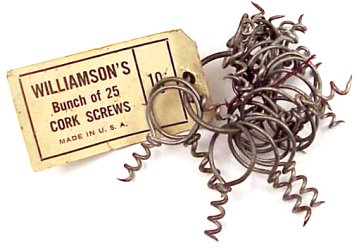
Looking for something to do with a bunch of these? See below.
From Popular Mechanics May 1911
Back in 1902 you could get them for free with your prescriptions at Jacob's Pharmacy in Atlanta:
Durol Packaging
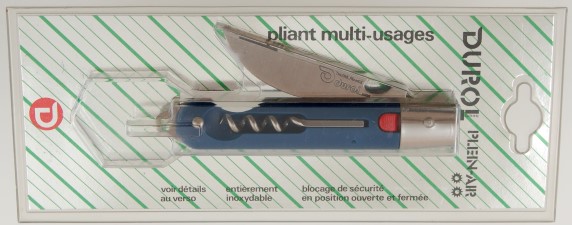
In the February 8, 2009 issue we looked at the French Durol patent. Here is one example of the Durol knife (without bottle opener) in the original packaging. (Courtesy of Jack Bandy).
|
©2009 Don Bull, Editor |